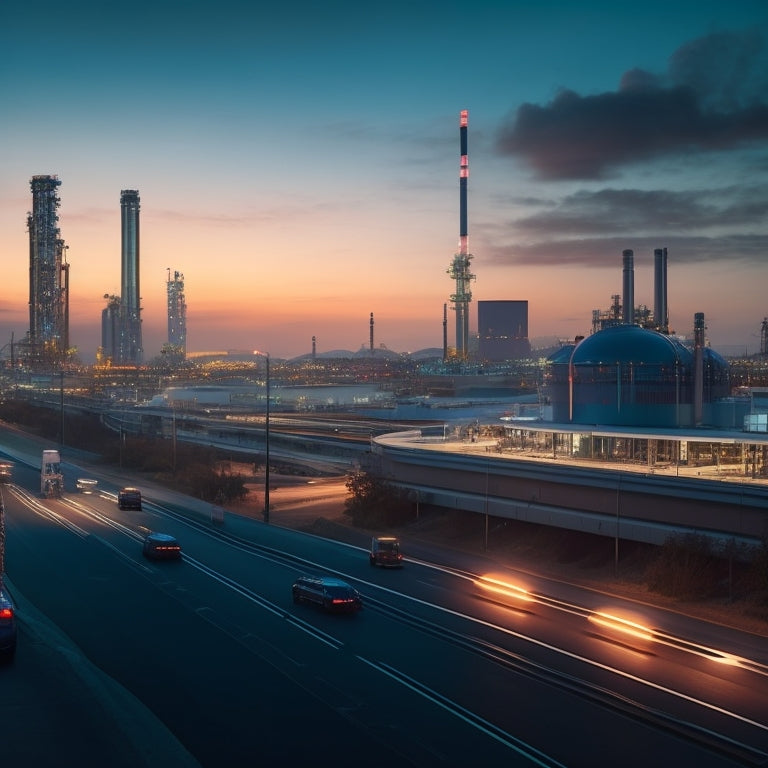
EVs Threaten Global Oil Demand, Dominance Imminent
Share
The global oil industry is on the cusp of a significant transformation as electric vehicles (EVs) are poised to dominate the market by 2030. Declining battery costs, improving technology, and supportive government policies are driving the shift. As a result, nearly half of global oil demand is at risk. The industry's traditional oil-based transportation sector is being disrupted, with oil demand for cars expected to decrease post-2030. The implications are far-reaching, and understanding the intricacies of this shift will be vital for stakeholders and policymakers alike. As the EV market continues to evolve, the future of oil demand hangs in the balance.
Key Takeaways
• By 2030, EVs are expected to dominate the global automotive industry, impacting oil demand and the oil industry as a whole.
• Nearly half of oil demand is at risk due to the rapid growth of EVs, disrupting the traditional oil-based transportation sector.
• Declining battery costs and improving technology are making EVs more competitive, leading to increased adoption and decreased oil demand.
• Government incentives, industry partnerships, and policy drivers are accelerating the EV transition, making them an attractive option for consumers.
• As EV sales increase sixfold by 2030, oil demand for cars is expected to decrease, marking a significant shift in the transportation sector.
Global Shift to Electric Vehicles
The global automotive industry is undergoing a profound transformation, with electric vehicles (EVs) poised to dominate the market by 2030, capturing a projected 62% to 86% of new vehicle sales. This shift is driven by declining battery costs, making EVs increasingly competitive with internal combustion engine vehicles.
As a result, the oil industry is bracing for impact, with nearly half of worldwide oil demand at risk due to the growing popularity of EVs. The EV market dynamics are expected to disrupt the traditional oil-based transportation sector, with oil demand for cars peaking in 2019 and expected to decrease by at least 1 million barrels per day post-2030.
This transformation will have far-reaching implications for the energy sector, with the oil industry facing significant disruption in the coming decades.
Regional EV Adoption Trends
Regional EV adoption trends vary greatly, with countries like China and India accelerating their EV deployment rates, while others, such as the EU, are already witnessing battery electric vehicles becoming cheaper to own than petrol and diesel cars.
In China, regional incentives and technology advancements are driving growth, with EV sales expected to reach 90% by 2030.
In contrast, the EU is seeing a surge in demand driven by consumer preferences and improving charging infrastructure.
India, meanwhile, is witnessing rapid growth, with EV sales tripling in just one year.
As regional incentives and technology advancements continue to improve, EV adoption rates are expected to accelerate, further threatening global oil demand.
Policy and Market Drivers
As governments and corporations increasingly commit to ambitious electrification targets, policy and market drivers are emerging as essential catalysts for the rapid adoption of electric vehicles.
Government incentives, such as tax credits and subsidies, are encouraging consumers to switch to EVs. Industry partnerships are also playing a key role, with companies like EV100 driving investment decisions at scale.
The ZEV declaration, signed by over 220 countries, aims to achieve 100% ZEV sales by 2040 globally. Additionally, the Accelerating to Zero Coalition targets 100% ZEV sales by 2035 in leading markets.
These policy and market drivers are accelerating the shift to EVs, making them an increasingly attractive option for consumers.
Accelerating the EV Transition
Rapid electrification of the transportation sector is essential to mitigate climate change, and several factors are converging to accelerate the EV shift, including declining battery costs, improving technology, and increasingly supportive policies. The convergence of these factors is driving EV market penetration, with global sales expected to increase sixfold by 2030. Technological advancements are playing a pivotal role in this shift, with battery costs falling by over 80% in the last decade.
| Region | EV Sales Growth | Purchase Price-Parity Tipping Point |
|---|---|---|
| Europe | 50% by 2025 | 2024 |
| China | 90% by 2030 | 2025 |
| US | 50% by 2026 | 2026 |
| India | 30% by 2027 | 2027 |
As the EV shift accelerates, it is imperative to continue driving innovation and policy support to achieve the desired pace of change.
Frequently Asked Questions
Can Governments Slow Down the EV Transition to Protect Oil Industry Jobs?
Governments can attempt to slow the EV shift by offering tax breaks, job retraining programs, and government subsidies to protect oil industry jobs, but such efforts may be insufficient against the tide of technological advancement and shifting consumer preferences.
Will EV Charging Infrastructure Be Able to Keep up With Demand?
As the urban landscape transforms, a harmonious marriage between public access and urban planning is essential to guarantee seamless EV charging infrastructure, mitigating congestion and supporting widespread adoption.
How Will EVS Impact the Resale Value of Traditional Combustion Cars?
As EVs gain traction, traditional combustion cars' resale value will plummet, with luxury brands experiencing steeper depreciation rates due to reduced demand, ultimately impacting their market value and desirability.
Can Oil Companies Adapt to the Shift Towards Electric Vehicles?
Oil companies can adapt to the EV shift by diversifying into alternative revenue streams, exploring new business models, and forming partnership opportunities, such as investing in EV charging infrastructure or renewable energy solutions.
Will the Rise of EVS Lead to Increased Electricity Demand and Grid Strain?
As the electric vehicle (EV) revolution accelerates, concerns arise about increased electricity demand and grid strain, particularly during peak hours, necessitating upgraded grid capacity to guarantee seamless integration and reliable power supply.
Related Posts
-

Smart Energy: Greener Homes With Connected Power Devices
You can control and optimize your energy consumption with smart energy devices, reducing your carbon footprint by up ...
-

What Roofing Materials Best Protect Our Planet?
As you consider the environmental impact of your building, you're likely to find that the roofing material you choose...
-

7 Top HEPA Filters for Green Building Projects
You need a reliable HEPA filter for your green building project that aligns with your sustainable goals and guarantee...


